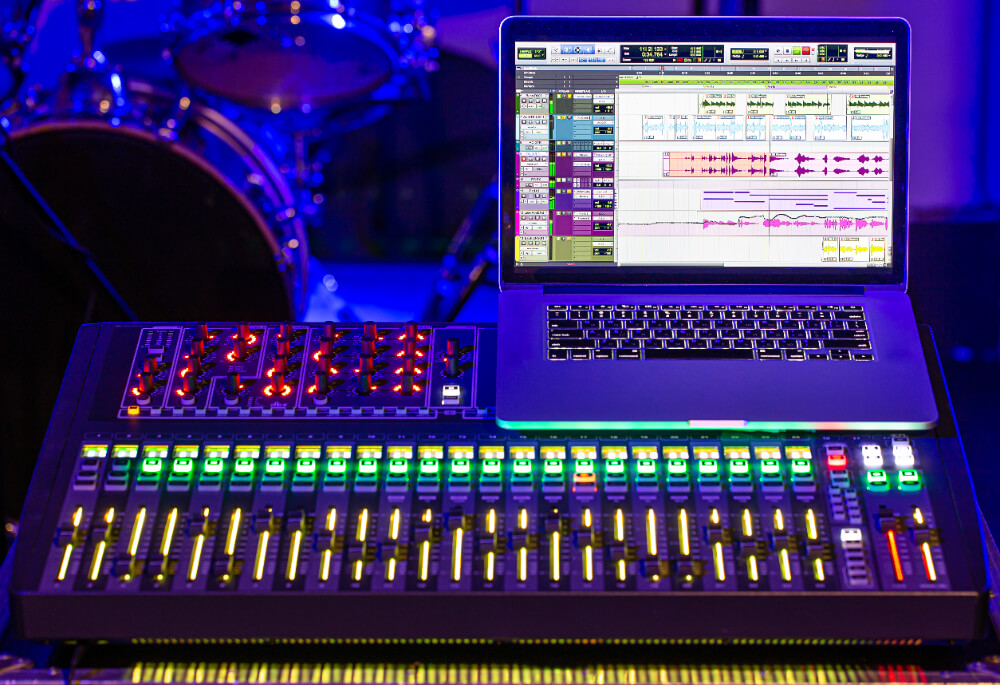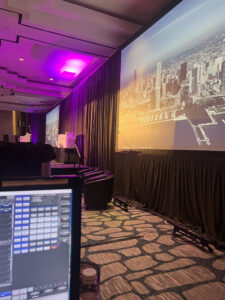Virtual trade shows are not only a trend but the future in event production. With the world moving to online and hybrid events, the potential to reach and interact is higher than ever before. However, with advantages also come special considerations, and not planning virtual events well can spoil even a well-organized show.
Here at Huview Production, we have helped dozens of virtual trade shows by providing expert AV services, and we learned that preventing small errors at the beginning can bring tremendous payoff: increased attendance, enhanced interactivity, delighted sponsors, and an increased number of leads. This is why we have prepared this guide to take you through the Top 10 Virtual Trade Show Mistakes to Avoid.
Each section below breaks down a common misstep, explains why it matters, and offers concrete strategies to fix it.
1. Not Setting Clear Goals and KPIs
When you have no clear goals, attending a virtual event is like trying to travel without planning the route. This often means events are not well-structured, attendees have trouble concentrating, and conclusions cannot be made easily after the event.
Here’s what you should do:
- Pick a primary goal. Examples: Generate 500 new leads, book 50 sales calls, collect 100 survey responses, or get 1,000 product demo views. Be specific.
- Set KPIs (Key Performance Indicators). These are numbers that show whether your event worked. Track things like registration count, live attendance, average session time, booth visits, click-through rates, or downloads.
- Make sure your goals are realistic. Look at past data or industry benchmarks. If this is your first event, start with simple targets you can measure easily.
- Track results in real time. Use dashboards or analytics tools to see what’s working and what’s not during the event. That way, you can adjust on the fly if needed.
2. Trying to Replicate an In-Person Event Exactly
Virtual events and in-person events are not the same. Making a virtual trade show look exactly like a physical event usually leads to low engagement and tired users.
Here’s why trying to replicate an in-person event doesn’t work:
- People behave differently online. Attention spans are shorter. Sitting through long sessions without breaks or interaction leads to drop-offs.
- Virtual events need to be shorter and more focused. Instead of full-day schedules, aim for shorter blocks with breaks in between. Stick to the point and keep sessions tight.
- Networking works differently. You can’t expect hallway conversations to happen naturally. You have to build in tools like breakout rooms, live chats, and scheduled meetups to help people connect.
- Booth visits aren’t automatic. At in-person events, attendees might stop by out of curiosity. Online, you need to actively drive traffic to virtual booths through links, shoutouts, or incentives.
- The energy is different. A live crowd brings natural excitement. Online, you have to create that energy through strong visuals, good hosts, and interactive tools.
Here’s what you should do:
Start by designing the experience for the screen, not for a convention center. Think about how your audience consumes content online. Make sessions interactive. Keep transitions smooth. Give attendees control over what they watch and when. Engagement plan, not just attendance.
3. Choosing the Wrong Virtual Event Platform
Your event platform sets the tone for the attendee experience. Selecting the wrong virtual trade show platform can ruin your event, regardless of how well everything else is planned.
If the event platform doesn’t work the way your team or audience needs, you’ll run into technical issues, low engagement, and unhappy attendees.
Here’s what you should do:
- Ease of use. Attendees shouldn’t need instructions to log in, join sessions, or visit booths. The platform should be simple to navigate, even for first-time users.
- Reliable streaming. Video and audio should be smooth with no lag or dropouts. If sessions crash or buffer constantly, people will leave.
- Live interaction features. Tools like Q&A, polls, chat, and breakout rooms help keep people involved. Without them, the event feels one-sided.
- Good reporting tools. You need access to data on attendance, engagement, booth visits, and more. If you can’t measure what’s happening, you can’t improve it.
- Tech support. If something goes wrong during the event, there should be fast, real-time help available from the platform provider.
4. Skipping Technical Rehearsals
Skipping a rehearsal is one of the biggest mistakes you can make when planning a virtual trade show. Even if your speakers are experienced or your platform seems reliable, things can still go wrong, often at the worst time.
Here’s why rehearsals matter:
- They catch technical issues early. Sound problems, camera angles, internet speed, and screen sharing problems are common. A rehearsal gives you time to fix them before the audience sees them.
- Speakers get comfortable. Some presenters know their content but struggle with the platform. Practicing helps them learn where to click, how to share slides, and how to manage the session smoothly.
- You test the flow of the event. A rehearsal shows how long transitions take, if there are delays between sessions, and whether speakers overlap or need better timing.
- Backup plans can be tested. If something breaks, what’s your plan? Rehearsals help you try out backups, like switching speakers, restarting streams, or using pre-recorded content.
- Team communication improves. Everyone knows their role and what to do if something doesn’t go as planned.
This is what you should do:
Schedule at least one full run-through a few days before the event. Include hosts, speakers, moderators, and tech staff. Use the same equipment and setup they’ll use during the live event. Make sure everyone knows who to contact for help and how to handle delays or errors.
Don’t treat rehearsals as optional. They’re a key part of making sure your event looks professional and runs without avoidable problems. A little preparation here can save a lot of stress later.
5. Failing to Engage Attendees
Virtual attendees are easily distracted. A virtual trade show must keep attendees involved, not just present.
Here’s why engagement matters:
- It prevents people from leaving early. If there’s no reason to interact, attendees will get bored and stop paying attention—or log off completely.
- It improves learning and retention. People remember more when they participate, ask questions, or make decisions during sessions.
- It boosts results. More interaction means more leads, more booth visits, and better outcomes for sponsors, exhibitors, and your team.
Here’s what you should do:
- Use live polls and Q&A. Give attendees a chance to ask questions or share opinions during sessions. It makes them feel part of the conversation.
- Add chat features. Let people talk to each other, ask speakers questions, or react in real time. It creates a sense of connection.
- Offer games, challenges, or prizes. Add some fun. Give people reasons to explore booths, attend sessions, or network.
- Include networking options. Use breakout rooms, one-on-one meeting tools, or virtual lounges to help attendees connect with each other.
- Keep sessions short and focused. Long presentations with no interaction don’t work well online. Break up content and include interactive elements every 5–10 minutes.
Give attendees ways to interact, participate, and connect, not just sit and watch. That’s what turns a passive viewer into an active participant.
6. Neglecting Sponsor & Exhibitor Value
Sponsors and exhibitors help fund your virtual trade show. If they don’t get value from the event, they won’t return, and word spreads fast.
Here’s what happens when they’re overlooked:
- They don’t get enough visibility. If their logos, booths, or sessions are hidden or poorly placed, attendees won’t notice them.
- They can’t connect with attendees. Without easy ways to chat, schedule meetings, or share offers, their lead generation drops.
- They feel like an afterthought. If their presence doesn’t feel supported or promoted, they’ll assume the event isn’t worth the investment.
Here’s what you should do:
- Offer visible branding. Place sponsor logos on session screens, email promotions, virtual lobbies, and key pages. Make sure people see their presence throughout the event.
- Set up virtual booths that work. Allow them to add videos, brochures, chat functions, and live reps. Make it easy for attendees to visit, ask questions, and request follow-ups.
- Promote them during the event. Mention sponsors in session intros, feature their content in email updates, and highlight their offers in announcements.
- Include them in lead-generation activities. Tie them into games, raffles, or special offers that drive traffic to their booth.
Sponsors and exhibitors are partners, not just buyers. If you don’t give them space, tools, and visibility, you’ll lose their support. Plan early, communicate clearly, and build value into every part of their experience.
7. Lack of Promotion Before the Event
If people don’t know your virtual trade show is happening, they won’t show up. Promotion is not something you do at the last minute; it needs to start early and follow a clear plan.
Here’s what happens when you skip this step:
- Low attendance. Even with great content, you won’t get results if your audience doesn’t hear about the event.
- Missed engagement. Without early buzz, people won’t register, share the event, or plan to attend key sessions.
- Frustrated sponsors and exhibitors. If turnout is weak, they won’t get the exposure or leads they expected.
Here’s what you should do:
- Build a timeline. Start promoting at least 4–6 weeks before the event. Don’t rely on a single announcement; use a steady stream of updates.
- Use multiple channels. Send emails, post on social media, run ads, write blog content, and share with partner networks. The more places your message appears, the more people you’ll reach.
- Highlight value. Don’t just say “register now.” Share why it’s worth attending, key speakers, live demos, giveaways, or networking chances. Make people want to be there.
- Create reminders. After someone registers, send follow-up emails and calendar invites. Use countdowns, sneak peeks, and session previews to build excitement.
- Get help from others. Ask speakers, sponsors, and exhibitors to share the event with their audiences. Give them ready-to-use graphics and sample posts to make it easy.
No matter how strong your event is, people won’t attend if they don’t hear about it or forget it’s happening. Promotion drives turnout. And turnout drives results. Make it a priority from day one.
Not sure where to start? Read How to Promote Your Virtual Trade Show and Get More Attendees? for practical tips on boosting visibility and turnout.
8. Not Gathering Feedback or Analyzing Results
If you don’t ask attendees what they thought or look at your event data, you miss the chance to improve next time.
Here’s why feedback and analysis matter:
- You won’t know what worked. Without input, you can’t tell which sessions, speakers, or features your audience liked.
- You won’t spot problems. Attendees may face issues you didn’t notice, like confusing navigation or poor audio quality.
- You miss growth opportunities. Understanding what your audience wants helps you plan better events and attract more people in the future.
- Sponsors and exhibitors need results. They want proof that their investment paid off. Sharing detailed reports keeps them on board.
Here’s what you should do:
- Send a short survey right after the event. Ask simple questions about content quality, technical experience, and overall satisfaction. Keep it quick to encourage more responses.
- Collect data from your platform. Look at attendance rates, session length, chat activity, booth visits, and downloads.
- Review and share findings with your team. Identify what went well and what needs fixing. Use this to plan your next event.
- Follow up with sponsors and exhibitors. Provide them with lead reports and engagement stats. Ask for their feedback too.
- Use feedback to make changes. Don’t ignore what you learn. Adjust your format, technology, or content based on what your audience and partners say.
Gathering feedback and analyzing results isn’t optional. It’s the key to making each event better than the last.
9. No Follow-Up Plan After the Event
Finishing your virtual trade show doesn’t mean your work is done. Without a clear follow-up plan, all the effort you put into the event can go to waste.
- Leads go cold fast. If you don’t reach out quickly, potential customers lose interest or forget about your product or service.
- Attendee engagement drops. People need reminders, additional information, or next steps to stay involved.
Here’s what you should do:
- Send thank-you emails. Reach out to attendees, speakers, sponsors, and exhibitors within 24–48 hours. Express appreciation and share key highlights or recordings.
- Provide clear next steps. Include links to book meetings, download materials, or register for future events.
- Segment your contacts. Tailor follow-up messages based on attendee behavior, such as sessions they attended or booths they visited.
- Share valuable content. Send presentations, FAQs, or exclusive offers to keep your audience interested.
- Schedule outreach for leads. Sales teams should contact prospects promptly with personalized messages referencing the event.
- Ask for referrals or feedback. Encourage attendees to share the event or give input for improvements.
Without follow-up, all the work before and during your virtual trade show can fade quickly. A solid plan keeps connections alive and turns one-time attendees into long-term relationships.
10. Ignoring Visual & Production Quality
Poor visuals and low production quality make your virtual trade show look unprofessional and distract attendees. If the video is blurry, audio cuts out, or slides are hard to read, people will lose interest fast.
Here’s why quality matters:
- It affects credibility. A polished, clear presentation builds trust. If the production looks cheap, people question your professionalism.
- It keeps attention. Good visuals and sound help people stay focused. Bad quality causes frustration and early drop-offs.
- It enhances the message. Clear graphics, sharp videos, and well-lit speakers make your content easier to understand and more engaging.
- It supports branding. Consistent, high-quality visuals reinforce your brand image and create a positive impression.
Here’s what you should do:
- Use high-quality cameras and microphones. Even basic upgrades make a big difference in how you look and sound.
- Test lighting. Make sure speakers are well lit with no harsh shadows or glare.
- Prepare clear, readable slides. Avoid clutter and use large fonts and simple graphics.
- Hire or assign a production lead. Someone should oversee audio, video, and graphics during the event to fix issues quickly.
- Run technical checks before the event. Confirm all visuals display properly on different devices and screen sizes.
- Keep backgrounds clean and professional. Avoid distracting or messy spaces behind speakers.
Ignoring visual and production quality costs you attendee trust and engagement. Invest in these details to deliver a smooth, professional event experience that keeps people coming back.
Final Thought
Many virtual trade mistakes come from poor planning and lack of technical oversight, both of which can be avoided by partnering with experienced Audio Visual production. Huview Productions is an audio visual production company in Atlanta that ensures that every aspect of your virtual trade show stage design, lighting, streaming, and engagement tools is executed flawlessly.
If you’re planning a virtual trade show and want reliable support, Huview Productions is here to help.







